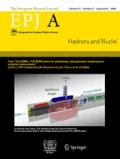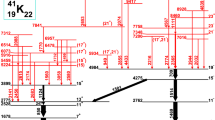Abstract
A first performance test of the Coulomb excitation multipolarimetry (Coulex-multipolarimetry) method is presented. It is based on a \(^{85}\hbox {Br}\,\pi p_{3/2}\rightarrow \pi p_{1/2}\) spin-flip experiment performed as part of the PreSPEC-AGATA campaign at the GSI Helmholtzzentrum für Schwerionenforschung (GSI). Via determination of background levels around the expected \(^{85}\hbox {Br}\) excitations as well as measured \(^{197}\hbox {Au}\) excitations, an upper limit for the M1 transition strength of the \(1/2_1^-\rightarrow 3/2_\text {g.s.}^-\) transition in \(^{85}\hbox {Br}\) and a lower beam time limit for upcoming experimental campaigns utilizing Coulex-multipolarimetry have been inferred. The impact of the use of AGATA in its anticipated \(1\pi \) configuration on these estimates is deduced via Geant4 simulations.









Similar content being viewed by others
Data Availability Statement
This manuscript has no associated data or the data will not be deposited. [Authors’ comment: The datasets generated during and/or analysed during the current study are available from the corresponding author on reasonable request.]
Notes
He-parameterization [17] for energy-loss calculations was used.
Ratio of measurable time in an arbitrary time window.
A \(2\sigma \) interval around the peak-of-interest was used for the P/B calculations.
Point of \(\gamma \)-ray emission not perfectly known.
References
R. Taniuchi et al., \(^{78}\)Ni revealed as a doubly magic stronghold against nuclear deformation. Nature 569, 53 (2019)
S. Franchoo et al., Beta Decay of \(^{68-74}\)Ni and level structure of Neutron–Rich Cu isotopes. Phys. Rev. Lett. 81, 3100 (1998)
S. Franchoo et al., Monopole migration in \(^{69,71,73}\)Cu observed from \(\beta \) decay of laser-ionized \(^{68-74}\)Ni. Physi. Rev. C 64, 054308 (2001)
K.T. Flanagan et al., Nuclear spins and magnetic moments of \(^{71,73,75}\)Cu: inversion of \(\pi 2p_{3/2}\) and \(\pi 1f_{5/2}\) levels in \(^{75}\)Cu. Phys. Rev. Lett. 103, 142501 (2009)
T. Otsuka et al., Evolution of nuclear shells due to the tensor force. Phys. Rev. Lett. 95, 232502 (2005)
T. Otsuka et al., Novel features of nuclear forces and shell evolution in exotic nuclei. Phys. Rev. Lett. 104, 012501 (2010)
C. Stahl et al., Identification of the proton \(2p_{1/2} \rightarrow 2p_{3/2}\) M1 spin-flip transition in \(^{87}\)Rb. Phys. Rev. C 87, 037302 (2013)
C. Stahl et al., Coulex-multipolarimetry with relativistic heavy-ion beams. Nucl. Instrum. Methods Phys. Res. A 770, 123 (2015)
N. Pietralla et al., On the road to FAIR: \(1^\text{st.}\) Operation of AGATA in PreSPEC at GSI, EPJ Web of Conferences 66, 02083 (2014)
H. Geissel et al., The GSI projectile fragment separator (FRS): a versatile magnetic system for relativistic heavy ions. Nucl. Instrum. Methods Phys. Res. Sect. B 70, 14 (1992)
P. Golubev et al., The Lund–York–Cologne Calorimeter (LYCCA): concept, design and prototype developments for a FAIR-NUSTAR detector system to discriminate relativistic heavy-ion reaction products. Nucl. Instrum. Methods Phys. Res. Sect. A 723, 55 (2013)
A. Akkoyun et al., AGATA-Advanced gamma tracking array. Nucl. Instrum. Methods Phys. Res. A 668, 26 (2012)
A. Maj et al., Angular distribution of photons from the decay of the GDR in hot and rotating light Yb nuclei from exclusive experiments. Nucl. Phys. A 571, 185 (1994)
A. Winther, K. Alder, Relativistic coulomb excitation. Nucl. Phys. A 319, 518 (1979)
J. Lindhard, A.H. Sørensen, Relativistic theory of stopping for heavy ions. Phys. Rev. A 53, 2443 (1996)
O. Tarasov, D. Bazin, LISE++: radioactive beam production with in-flight separators. Nucl. Instrum. Methods Phys. Res. B 266, 4657 (2008)
F. Hubert et al., Range and stopping-power tables for 2.5–500 MeV/nucleon heavy ions in solids, Atomic Data and Nuclear Data 46, 1 (1990)
N. Lalović et al., Performance of the AGATA \(\gamma \)-ray spectrometer in the PreSPEC set-up at GSI. Nucl. Instrum. Methods Phys. Res. A 806, 258 (2016)
R. Hoischen et al., Fast timing with plastic scintillators for in-beam heavy-ion spectroscopy. Nucl. Instrum. Methods Phys. Res. A 654, 354 (2011)
M. Reese et al., Position sensitivity of LYCCA time-of-flight detectors. GSI Rep. 2013–1, 185 (2013)
M. Reese, Intermediate-energy Coulomb excitation with the PreSPEC-AGATA setup, Ph.D. thesis, Technische Universität Darmstadt, (2018)
C. Bertulani, A computer program for relativistic multiple Coulomb and nuclear excitation. Comput. Phys. Commun. 116, 23 (1999)
C. Bertulani, DWEIKO, http://cpc.cs.qub.ac.uk/summaries/ADRN_v1_0.html. Accessed 21 Oct 2019
A.E. Stuchbery et al., Measured gyromagnetic ratios and the low-excitation spectroscopy of \(^{197}\)Au. Nucl. Phys. A 486, 374 (1988)
S. Agostinelli et al., Geant4 – a simulation toolkit. Nucle. Instrum. Methods Phys. Res. A 506, 250 (2003)
J. Allison et al., Geant4 developments and applications. IEEE Trans. Nucl. Sci. 53, 270 (2006)
J. Allison et al., Recent developments in GEANT4. Nucl. Instrum. Methods Phys. Res. A 835, 186 (2016)
E. Farnea et al., Conceptual design and Monte Carlo simulations of the AGATA array. Nucl. Instrum. Methods Phys. Res. A 621, 331 (2010)
H. Essel, N. Kurz, The general purpose data acquisition system MBS, 1999 IEEE Conference on Real-Time Computer Applications in Nuclear Particle and Plasma Physics 475, (1999)
H. Essel et al., The new data acquisition system at GSI. IEEE Trans. Nucl. Sci. 43, 1 (1996)
G.F. Knoll, Radiation detection and measurement, vol. 4 (Wiley, New York, 2010)
E. Clément, Conceptual design of the AGATA \(1\pi \) array at GANIL. Nucl. Instrum. Methods Phys. Res. A 855, 1 (2017)
D. Bazzacco, Nucl. Phys. A 746, 248 (2004). (Proceedings of the 2029 Sixth International Conference on Radioactive Nuclear Beams (RNB6))
R.M. Lieder et al., The TMR network project “Development of \(\gamma \)-ray tracking detectors”. Nucl. Phys. A 682, 279c (2001)
A. Korichi, T. Lauritsen, Tracking \(\gamma \) rays in highly segmented HPGe detectors: a review of AGATA and GRETINA. Eur. Phys. J. A 55, 121 (2019)
A. Lopez-Martens et al., \(\gamma \)-ray tracking algorithms: a comparison. Nucl. Instrum. Methods Phys. Res. A 533, 454 (2004)
H. Geissel et al., Technical design report on the super-FRS. Technical report (GSI, Darmstadt, 2009)
Zs. Podolykák, The high-resolution in-flight spectroscopy (HISPEC) project at FAIR. Int. J. Mod. Phys. E 15, 1967 (2006)
Acknowledgements
The authors want to thank A. Lopez-Martens for helpful advice on possible analysis methods and U. Friman-Gayer for statistics-related advice. In addition, the authors want to thank the AGATA collaboration for providing the necessary data. This work was supported by the German BMBF under Grant Numbers 05P19RDFN1, 05P18RDFN9 and 05P19PKFNA, the Bulgarian National Science fund under grant number DN 08/23, the Swedish Research Council under contracts Nos. 2010-147, 2011-5253 and 2011-6127, HGS-HIRe and HIC for FAIR. This work has been supported by the European Community FP7–Capacities, ENSAR Contract No. 262010.
Author information
Authors and Affiliations
Corresponding author
Additional information
Communicated by Calin Alexandru Ur
Rights and permissions
About this article
Cite this article
Napiralla, P., Lettmann, M., Stahl, C. et al. Benchmarking the PreSPEC@GSI experiment for Coulex-multipolarimetry on the \(\pi (p_{3/2})\rightarrow \pi (p_{1/2})\) spin-flip transition in \(^{85}\hbox {Br}\). Eur. Phys. J. A 56, 147 (2020). https://doi.org/10.1140/epja/s10050-020-00148-2
Received:
Accepted:
Published:
DOI: https://doi.org/10.1140/epja/s10050-020-00148-2




